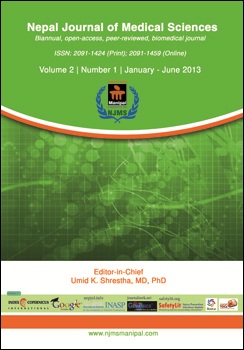Amblyopia and amblyopia treatment study
DOI:
https://doi.org/10.3126/njms.v2i1.7656Keywords:
Amblyopia, Amblyopia Treatment Studies, PatchingAbstract
Amblyopia comes from the Greek word meaning dull sight or blunt sight. Amblyopia occurs to abnormal visual experience early in life. It can be both unilateral (U/L) and/or bilateral (B/L). Amblyopia itself produces no change in the appearance of ocular structures, but it nearly always develops in association with some other condition that is evident on physical examination, and which is responsible for abnormal visual experience. It is one of the most common causes of visual impairment in childhood. Unless it is successfully treated in early childhood, amblyopia usually persists into adulthood. In 1997, the pediatric eye disease investigator group (PEDIG) was formed to conduct clinical research in eye disorders affecting children. The studies were conducted through simple protocols with limited data collection and implemented by both university and community based pediatric eye care practitioners as part of their routine practice in USA. Hence PEDIG has laid emphasis on studies of treatment modalities of amblyopia, the Amblyopia Treatment Studies (ATS). The recent general guidelines for occlusion therapy are based on ongoing ATS. New concepts of management on amblyopia are practiced now- a-days based on ATS. This article is an update on amblyopia and its management.
Nepal Journal of Medical Sciences | Volume 02 | Number 01 | Jan-Jun 2013 | Page 66-72
DOI: http://dx.doi.org/10.3126/njms.v2i1.7656Downloads
Downloads
Published
How to Cite
Issue
Section
License
Copyright © by Nepal Journal of Medical Sciences. The ideas and opinions expressed by authors of articles summarized, quoted, or published in full text in this Journal represents only opinions of authors and do not necessarily reflect the official policy of Nepal Journal of Medical Sciences or the institute with which the author(s) is (are) affiliated, unless so specified.




